Part 3: Moving Forward
Closed10 Aug, 2015, 3:20pm - 25 Sep, 2015, 3:20pm
A Sustainable Approach to the Management and Maintenance of Open Space in Fingal
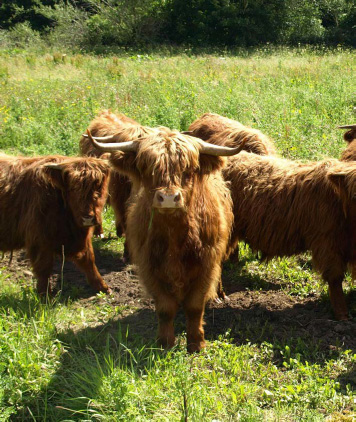
Grazing project at St Catherine’s Park, Lucan
3.1 Introduction
This part of the strategy outlines a new approach to open space management conservation and maintenance. This reflects a move away from the reactive and routine tradition of management which has been in place, towards a more proactive and planned approach to open space management conservation and maintenance. There is currently no objective standard for comprehensively assessing the quality of existing open space in Fingal. Several of the actions outlined below help to address deficiency.
This strategy will build on the foundations developed by the Council and contained in existing policy documents, including: ‘The Green Infrastructure Plan’ (Chapter 5 of Fingal Development Plan 2011-2017); ‘The Forest of Fingal
- A Tree Strategy for Fingal’; ‘Fingal Biodiversity Action Plan’ and ‘The Fingal Allotment Strategy’.
The core principles for the sustainable management of open space in Fingal are:
|
The following three major initiatives will deliver the changes necessary for enhanced sustainability and the overall quality of open space provision.
|
3.2 Proposed Open Space Management and Maintenance Hierarchy
The following is the proposed hierarchy of maintenance of open space. This reflects the profile of different areas of open space under maintenance. It is important in establishing this hierarchy that risk management is addressed, as well as the usage pattern and amenity value of the open spaces in question.. It is proposed to prioritise the maintenance of the following elements of public open space in line with this hierarchy and according to their typology as follows:
• Playgrounds
• Sports Facilities
• High Profile Open Space in towns and villages
• Open Space within Residential Areas
• Grassed Roadside Margins
| It should be noted that Regional Parks and Heritage Properties require particular attention on a stand alone basis and this is dealt with by way of individual Management Plans for these properties |
Playgrounds
Playgrounds are highly valued in local areas. Due to their popularity, heavy use and the potential consequences of vandalism, they must be inspected regularly and maintained in a ‘fit for purpose’ condition. Playgrounds are inspected regularly and maintenance requests are forwarded to the local supervisory staff for action. Playground repairs and maintenance will receive the highest priority. Potential for accidents where equipment is faulty can be lethal. As a result of this significant risk that may occur, public safety is a priority.
Sports Facilities
The Council directly provides a major part of the facilities used for sports and outdoor recreation in Fingal (See Table 1). The maintenance of sports grounds is of critical importance to clubs in Fingal, some of which rely almost exclusively on the Council for their facilities. Over 400 teams from more than 60 sports clubs use these outdoor facilities. Severe disruption would therefore result if they are not maintained to an acceptable and safe level. The Council supports the objective of an active population which is a national goal and significantly enhances public health. For these reasons, maintenance of sports facilities is second on the priority list.
Public Sports & Playing Facilities in Fingal
Facilities |
Quantity |
|
Grass pitches |
168 |
|
Changing rooms |
46 |
|
Tennis courts |
46 |
|
Playgrounds |
39 |
|
Multi use games areas (MUGA) |
9 |
|
All weather pitches |
8 |
|
Mini pitches |
5 |
|
Cricket pitch |
5 |
|
Basketball courts |
4 |
|
Golf courses (full size) |
2 |
|
Golf courses (par 3) |
2 |
|
Pitch and putt courses |
2 |
|
Bowling greens |
2 |
|
Driving range |
1 |
|
BMX track |
1 |
|
Skate park |
2 |
|
Traditional Farm |
1 |
High Profile Open Space in towns and villages
These spaces include town parks and visually significant open spaces on the approaches to or in the centres of towns and villages. These spaces are important in social and economic terms and in creating a sense of place. They leave a lasting impression of a locality and also significantly affect residents’ views of the village or town in which they live. It is therefore important to ensure these impressions are positive both for visitors and residents alike. Scores achieved in ‘Tidy Towns’ competitions are a good barometer of how well these spaces are maintained. Open spaces identified as falling into this category will accordingly have a high priority rating.
Open Space within Residential Areas
These open spaces are used primarily for passive recreation and the frequency and nature of the maintenance carried out will reflect this. These are the open spaces most closely identified with and related to particular residential developments. Engagement with these communities in relation to the maintenance strategies adopted for these areas is therefore essential.

Grass Maintenance in Open Space
Grassed Roadside Margins
Distributor roads, margins running alongside open space and entrances to estates not overlooked by businesses and dwellings are maintained by The Council. These areas are usually narrow and have a significant number of street trees, public light standards and signs located on them. They are also used as service runs for electricity, gas and telecommunications cables. This significantly increases the labour required to maintain them.
It is proposed to maintain them as follows:
|
Regional Parks and Heritage Properties
Fingal is unique among Local Authorities in Ireland in that approximately 800 hectares of its open space resource is located in designed historic landscapes. These areas are sometimes referred to as destination parks as
most visitors make a special trip to visit them. Some have coffee shops and other facilities and generate income to help defray maintenance costs to the Council. Due to their size and location, they often have many elements ranging from highly maintained walled gardens and lawns to playing pitches, playgrounds, woodland areas, wildflower meadows and protected heritage structures. Unlike most open spaces, they contain a significant amount of woodland with many mature and sometimes over-mature trees that require specialised management. In some of these parks it has been possible to
convert large areas of mown grass into wildflower meadows. Most visitors value this and enjoy walking on mown paths through the meadows. The wildflower meadows in Ardgillan and Newbridge were assessed in 2009 and rated as being in the top 10 sites in the country for biodiversity. This move to wildflower meadows with local farmers harvesting hay has significantly improved the sustainable maintenance of these parklands.
| Conservation and Management Plans for both the built and natural heritage within these parks are being prepared. These will form the basis of long term management for these parks and will include significant initiatives to enhance the amenity and tourism potential of each property. |
3.3 Guidance for the Planning, Management and Maintenance of Open Space
The Council addresses the planning, provision and maintenance of high quality open space through a number of processes. In relation to the development of open space, detailed requirements are communicated to developers through the Planning Process and address the following areas:
|
Open Space Planning and Design Guidelines
In future a stronger emphasis on sustainable maintenance will inform the layout and arrangement of open spaces. This will avoid The Council taking in charge ‘left-over’ space that has few benefits and can be difficult and expensive to maintain.
The open space layout and design guidelines are as follows:
|
•
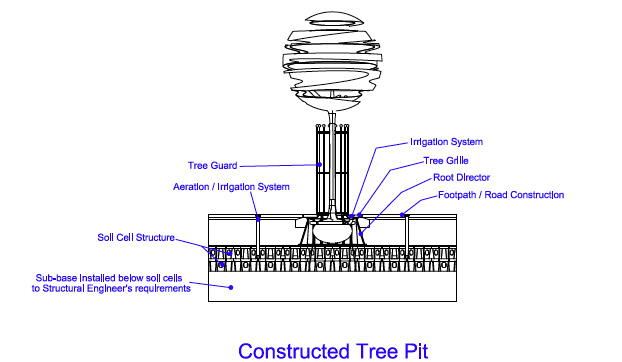
Planting and Grass Maintenance on Open Space
The Council aims to carry out the necessary planting and grass maintenance in such a way that public open space has an acceptable visual amenity and meets its usage requirements.
The guidelines for planting and grass maintenance are as follows:
|
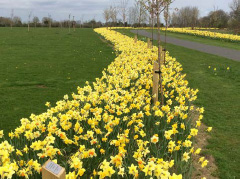
Mass bulb planting under trees
The Green Flag Award Scheme
While there is currently no objective standard for the provision of quality open space the ‘Green Flag Award Scheme’ is currently being piloted in Fingal. If adopted county-wide, this will introduce an objective standard in the provision and maintenance of quality open spaces. The ‘Green Flag Award Scheme’ is the national standard for parks and green spaces in the UK. It was first launched in 1996 to recognise and reward the best green spaces in that country. It provides the high level of quality against which parks and green spaces are measured. It is also seen as a way of encouraging others to achieve high environmental standards, setting a benchmark of excellence in recreational green areas.
‘Green Flag Award’ applications are judged against eight key criteria. The judging criteria also considers the fact that each park/green space will offer different kinds of facilities, and will be managed and developed to varying opportunities and constraints. Innovation and the way facilities offered are tailored to the needs of the community will also be taken into account. The Green Flag scheme also requires the development of management plans for the candidate parks which in turn will lead to the development of qualitative standards for the management of these parks and open spaces.
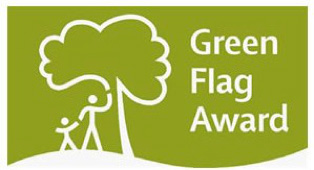
The Green Flag Award Scheme for Parks
The criteria used for judging the open spaces are as follows:
1 A welcoming place
2 Healthy, safe and secure
3 Clean and well maintained
4 Sustainability
5 Conservation and heritage
6 Community involvement
7 Marketing
8 Management
It is likely that these criteria will be adapted and refined over time to reflect the Irish context.
Sustainable Urban Drainage Systems (SuDS) on Open Space
Sustainable Urban Drainage Systems (SuDS) can best be defined as offering a “total” solution to rainwater management and must be included in all new developments. Ponds, artificial wetlands and water features can make a positive contribution to the provision of Sustainable Urban Drainage Systems (SuDS) and to the amenity of an area. Properly designed and located SuDS features can be incorporated within and can complement the amenity and aesthetic value of open spaces. SuDS areas do not form part of the public open space provision, except where they contribute in a significant way to the design and quality of open space. The current Fingal Development Plan
2011 -2017 includes the following objective:
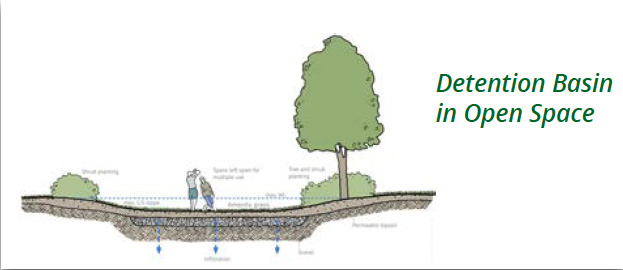
Detention Basin in Open Space
Objective OS25
| Ensure as far as practical that the design of SuDS enhances the quality of open spaces. SuDS do not form part of the public open space provision, except where it contributes in a significant and positive way to the design and quality of open space. In instances where the Council determines that SuDS make a significant and positive contribution to open space, a maximum 10% of open space provision shall be taken up by SuDS. |

Planted Drainage Swale on Open Space
While the above objective sets out at maximum of 10% open space provision to be taken up by SuDS, there may be situations in larger open spaces and particularly in major regional parks where this maximum limit may need to be reassessed in the interests of good design and sustainable management.
Larger Open Spaces:
For larger parks including Local, Neighbourhood and Regional Parks and open spaces in excess of 2 Hectares, the construction of Attenuation Ponds and Detention Basins will be favoured as SuDS solutions.
Smaller Open Spaces
In smaller Residential Open Spaces less than 2 Hectares or within roadside margins the construction of Filter Strips/Drains and Planted Swales, will be considered appropriate as options to meet local SuDS requirements. In these areas, Constructed Tree Pits incorporating SuDS elements will also be considered appropriate especially in smaller paved open spaces such as
Pocket Parks or high profile civic spaces.
Parkland and Open Space Furniture
Furniture for open space is essential and an important element of any open space area. This includes benches, lighting, litter bins and adult outdoor exercise equipment. The Council aims to provide furniture which complements the character of the area, responds to site attributes and features, e.g. views, landmarks and existing vegetation; is appropriately scaled and, where necessary, responds to the local heritage.
The guidelines for parkland and open space furniture are as follows:
|
3.4 Policy for Memorial Dedication of Benches and Trees
The Council supports the general principle of allowing memorial benches and trees in its parks. The Council is however mindful that the public use and enjoy these spaces for a range of reasons and it is important therefore to ensure that the issue is managed and regulated for the benefit of all. To this end memorial benches and trees will only be considered for inclusion in parks and open spaces where there are high levels of passive and /or active supervision e.g. Enclosed Regional Parks and Heritage Demesnes.
Significant memorials such as the naming of parks or commemoration of historic events in parks and open spaces will require an application in writing to the appropriate naming committee in The Council.
For commemorative benches and tree planting, the Council will accept contributions (subject to the availability of suitable locations), under the following conditions:
Trees
The location of the tree and selection of tree species shall be at the discretion of the Council which is responsible for the planting and maintenance works required. A fee will be charged as a contribution to the cost of this work including administration. Plaques or memorabilia will not be permitted in the vicinity of the tree. The sponsor shall be required to meet the cost of these works. In the event of vandalism or failure (within 18 months of planting), the Council will arrange on a one-off basis for a replacement.
Benches
The Council will attempt to accommodate the wishes of the applicants in relation to the selection of the bench type, its location, installation and style of plaque. However, consideration has to be given to the ambiance and management plan for any particular park so the final decision on these issues will be at the discretion of the Council.
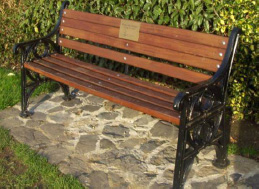
Memorial Bench
Inscriptions
The inscription on the plaque will be required to be non-denominational. Dates that indicate lifetime may not be used and wording must be approved by the Council. The applicant shall be required to contribute the full cost of purchasing and installing the bench and associated plaque.
General Conditions
The Parks Service reserves the right to remove or relocate a bench or tree at any time should it be considered necessary.
The Council will maintain responsibility for the bench for a minimum of 5 years. This will include any repair works and replacement of the bench where required due to normal wear and tear or vandalism. Should a bench become unsafe, the Council reserves the right to remove it immediately in the interest of public safety until repairs or replacement can take place. A bench that has been damaged and is in the view of the Council beyond economic repair may not be replaced beyond 5 years after the date of first installation.
The Council accepts no liability for damage to any benches, trees or shrubs from vandals, third parties or whilst the Council carries out routine maintenance in the park. The Council will not accept applications for memorial benches or trees dedicated to pets. No additional memorabilia e.g. vases, statues, flowers, wreaths, balloons or other ornamentation etc., shall be permitted on or around the bench. These shall be removed without reference to the original applicant.
Applications for commemorative trees or benches should be sent in writing to The Administrative Officer, Operations Department, The Council, Civic Offices, Grove Road, Blanchardstown, Dublin 15.
This section will be uodated from time to time in line with the changes to the Councils Memorial Policy.
3.5 Community Involvement in Open Space
Community appreciation, involvement and identity will be fostered through the development and use of open space.
Community and resident groups shall be encouraged to participate in appropriate open space maintenance initiatives in agreement with the Council, e.g. the ‘Adopt a Patch’ Scheme which is run by the Council’s Environment Department to facilitate local groups to clean up and maintain local residential areas. The ‘Green Flag Award Scheme’ now being piloted will be rolled out to include community involvement criteria.
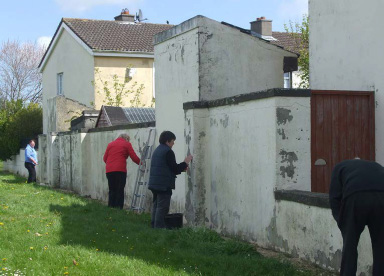
Adopt a Patch Scheme with Local Residents
3.6 Biodiversity and the Fingal Growing Places Initiative
The ‘Fingal Biodiversity Action Plan’ provides advice and direction for the management of biodiversity located in Fingal’s Open Spaces and parks.
The maintenance of public open space is underpinned by a biodiversity ethos and the ‘Growing Places Initiative’. For a number of years, The Council has piloted a new and more sustainable approach to open space maintenance involving the introduction of a range of new practices relating to these works. The collective term for these practices is the ‘Growing Places Initiative’. The core of this initiative is to ensure the maintenance regime used in a given location reflects the profile and usage pattern of the site in question. In addition, this approach aims to enhance biodiversity through developing a range of conditions and habitats in open spaces. This more stratified approach to open space is common in many developed countries.
The key elements of the initiative which have been piloted to date are as follows:
|

Making Hay on Wildflower Meadow in Open Space
Involvement of Local Communities in decisions and activities relating to the maintenance and development of their local open spaces and parks.
The guidelines for Biodiversity and Growing Places Initiative are as follows:
|
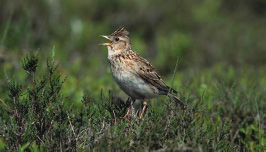
Birds such as Skylarks benefit from wildflower meadow habitats
3.7 Guidelines for Archaeology and Open Space
Fingal is rich in archaeology extending over thousands of years with numerous mounds, ringforts, cairns, passage tombs, monastic sites, castles, ruins of early churches, burials, etc. scattered throughout the County.
Historic Landscape Characterisations (HLC) have been carried out for certain areas of Fingal analysing the different periods of development of an area, highlighting archaeologically sensitive landscapes in the case of Balbriggan, and assisting in distinguishing significant groups of monuments. HLC studies for the environs of Swords, Balbriggan and the Donabate/ Portrane peninsula have been completed.
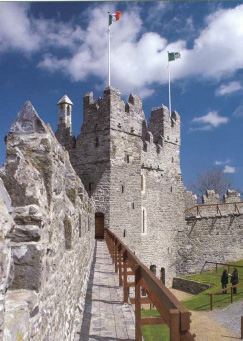
Swords Castle in Swords Town Park
The guidelines for Archaeology and open space are as follows:
|
3.8 Parks and Open Spaces Bye-Laws – Proposed Changes
The management and usage of open space in Fingal is currently governed by Council bye-laws. These bye-laws are adopted in accordance with Part VII of the Local Government Act, 1994, for the control and regulation of the use of parks, open spaces and recreational playing grounds.
The ‘Regional Parks and Open Spaces Bye-Laws 1999 as amended by the The Council (Prohibition of Consumption of Intoxicating Liquor on Roads and in Public Places) Bye-Laws 2002’ (Appendix B) are in force to ensure that these open spaces are used in safety and comfort.
These bye-laws outline regulations in relation to a range of issues including but not limited to:
• Opening and Closing times
• Unauthorised Entry
• Drug and alcohol usage
• Licencing of Activities and Trading
• Litter, Graffiti and Vandalism
• Children’s Playgrounds
• Traffic
• Animals
• Public Disorder
• Games and Athletics
• Bonfires, Barbecues etc.
To reflect current usage patterns and the need for more sustainable management of our open spaces it is proposed to amend the Bye-laws in relation to a number of issues. The formal process for adoption of the amended Bye-laws will be pursued following the adoption of this Open Space Strategy.
The proposed changes to the current bye-laws under the following headings are outlined below.
Traffic (Cycling & Parking)
Currently the bye-laws include a general prohibition on cycling and similar activities in parks as follows: “No person shall cycle or use any skateboard, roller skates, roller blades, or other vehicle in the park except on such routes and in such places as may be designated by the Council for this purpose.”
The following proposed amendments will permit the wider use of bicycles, skateboards, in-line skates, roller-skates, non-motorised scooters and similar vehicles in designated areas and on designated routes subject to due care and consideration for other Park users.
Currently a maximum speed limit of 10MPH applies to all authorised vehicles on authorised routes in parks. It is proposed that a maximum speed limit of
20KPH shall apply to all parks and open spaces with the exception of areas specifically designated for cycle training and racing or by prior agreement with the Council.
| Currently the bye-laws prohibit cycling in parks and open spaces outside of designated routes. To facilitate young children learning to cycle; it is proposed that this bye-law shall not apply to bicycles or tricycles ridden by children under the age of 10 years who are accompanied by and under the care of an adult. It is proposed that these Bye-Laws shall not apply to wheelchairs, perambulators or similar vehicles moved, drawn or propelled by hand or mechanically which are used solely for the conveyance of children or disabled persons. |
In addition it is proposed to include the following amendments to the Byelaws:
|
Smoke free Playgrounds
In 2012 following extensive research and public consultation; The Council introduced a policy of smoke free playgrounds. This requires members of the public to refrain from smoking in public playgrounds managed by The Council. It is now proposed to revise the Parks & Open Space Bye-laws to incorporate this provision as follows:
|
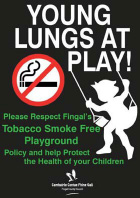
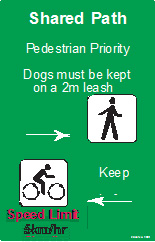
Animals (Dogs)
The current Bye-Laws require that no dogs shall be permitted in the parks unless they are “on a leash or under adequate control”.
The proposed amendments state:
|
Events
The current bye-laws address the provision of Musical Performances, Dances, etc. and Games and Athletics.
The proposed amendment states:
| All events in parks and open spaces shall be organised in line with Event Management Guidelines and Protocols as adopted by The Council. |

Outdoor Theatre at Newbridge Demesne
Commercial Activity (Bootcamps and Personal Trainers)
Currently, trading or other commercial activities in any park are not permitted without the permission of The Council. These bye-laws shall remain in place.
|
Due to a recent surge in commercial activity and in particular ‘Boot camp’ and ‘Personal Trainer’ style classes these provisions will be highlighted in the amended Bye-Laws.
|
Use of Model Aircraft/Drones in public open spaces
The current bye-laws limit the use of model aircraft and similar equipment in parks and open spaces as follows:
| “No person shall operate any model aircraft, model sailing vessel or any model mechanically propelled vehicle save with the permission in writing of the Council and subject to the terms and conditions of such permission.” |
In recent times there is evidence of an increasing number of Hi-Tec model aircraft, Drones or Remotely Piloted Aircraft (RPAs) being purchased by members of the public. The increasing use of drones in public open space may well lead to conflict with other park users. The issue is further complicated by the fact that many of these aircraft have very sophisticated photographic capabilities. Currently the Irish Aviation Authority (IAA) licences the use of drones for various purposes including aerial photography. The current relevant park bye-law is quite restrictive with regard to this activity and may prove difficult to enforce. A more sustainable and positive approach might be to provide that the Council designate certain areas at certain times as suitable for this activity subject to the requirements of the IAA and other privacy, health & safety and insurance related issues being met.
The suggested revised text is as follows:
| “No person shall operate any drone, remotely piloted aircraft, model aircraft, model sailing vessel or any model mechanically propelled vehicle in a public park or open space except in locations or a times designated by the Council for such activities and subject to the requirements of the Irish Aviation Authority (IAA) or other relevant statutory bodies and subject also to the Council’s requirements in relation to privacy, health & safety and insurance being met.” |
Conclusion
The making of bye-laws is a separate statutory process involving public consultation and the approval of the elected Council. The policy will be updated to reflect the outcome of this process
The wide range of proposals and initiatives outlined above will when implemented result in a more coherent and sustainable approach to the maintenance and management of public open space in Fingal. Updated bye-laws will make our open spaces more relevant to the everyday lives of citizens and revised maintenance regimes will reflect how these spaces are actually used while opening up new possibilities for recreation and enjoyment.